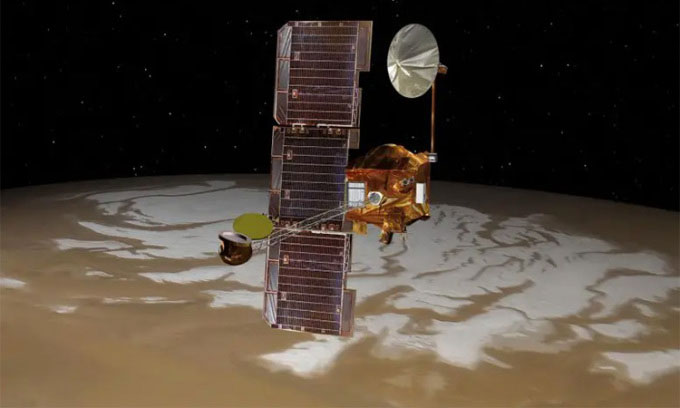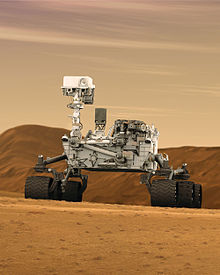WASHINGTON – After studying Mars four times as long as originally planned, NASA’s Mars Global Surveyor orbiter appears to have succumbed to battery failure caused by a complex sequence of events involving the onboard computer memory and ground commands.

Simulation of NASA’s Mars Odyssey spacecraft passing above the Martian south pole. (Photo: NASA/JPL-Caltech).
The causes were released today in a preliminary report by an internal review board. The board was formed to look more in-depth into why NASA’s Mars Global Surveyor went silent in November 2006 and recommend any processes or procedures that could increase safety for other spacecraft.
Mars Global Surveyor last communicated with Earth on Nov. 2, 2006. Within 11 hours, depleted batteries likely left the spacecraft unable to control its orientation.

Artist concept of Mars Global Surveyor.
Image credit: NASA/JPL-Caltech
Related Links:
MGS Loss of Contact >>
Important Discoveries >>
“The loss of the spacecraft was the result of a series of events linked to a computer error made five months before the likely battery failure,” said board Chairperson Dolly Perkins, deputy director-technical of NASA Goddard Space Flight Center, Greenbelt, Md.
On Nov. 2, after the spacecraft was ordered to perform a routine adjustment of its solar panels, the spacecraft reported a series of alarms, but indicated that it had stabilized. That was its final transmission. Subsequently, the spacecraft reoriented to an angle that exposed one of two batteries carried on the spacecraft to direct sunlight. This caused the battery to overheat and ultimately led to the depletion of both batteries. Incorrect antenna pointing prevented the orbiter from telling controllers its status, and its programmed safety response did not include making sure the spacecraft orientation was thermally safe.
The board also concluded that the Mars Global Surveyor team followed existing procedures, but that procedures were insufficient to catch the errors that occurred. The board is finalizing recommendations to apply to other missions, such as conducting more thorough reviews of all non-routine changes to stored data before they are uploaded and to evaluate spacecraft contingency modes for risks of overheating.
“We are making an end-to-end review of all our missions to be sure that we apply the lessons learned from Mars Global Surveyor to all our ongoing missions,” said Fuk Li, Mars Exploration Program manager at NASA’s Jet Propulsion Laboratory, Pasadena, Calif.

Control room at JPL.
Mars Global Surveyor, launched in 1996, operated longer at Mars than any other spacecraft in history, and for more than four times as long as the prime mission originally planned. The spacecraft returned detailed information that has overhauled understanding about Mars. Major findings include dramatic evidence that water still flows in short bursts down hillside gullies, and identification of deposits of water-related minerals leading to selection of a Mars rover landing site.

The Mars Science Laboratory Project is part of NASA’s Mars exploration program managed by JPL
The Jet Propulsion Laboratory, Pasadena, Calif., manages Mars Global Surveyor for NASA’s Science Mission Directorate, Washington. Lockheed Martin Space Systems, Denver, developed and operates the spacecraft.
—
Guy Webster 818-354-6278Jet Propulsion Laboratory, Pasadena, Calif.
Dwayne Brown 202-358-1726NASA Headquarters, Washington
Scource: NASA








